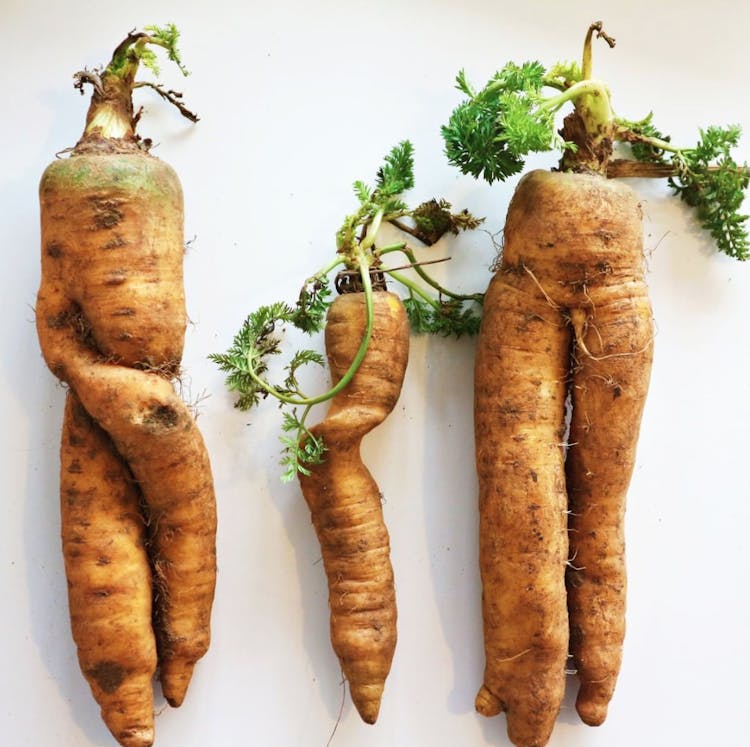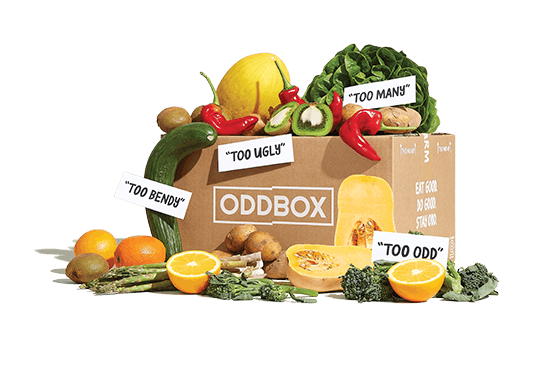The history behind our 'perfect' fruit & veg
What's happened to the odd-shaped, misshapen fruit and veggies of the past? Here we go into the history of fruit and veg, and why we only see perfect fruit and veg in supermarkets.

THE HISTORY BEHIND OUR PERFECT FRUIT AND VEG
These days, our supermarket shelves are lined with perfectly red tomatoes, uniformly shaped bananas and straight carrots. What did vegetables used to look like, only a few decades ago? Those very fruit and veggies were odd-looking, misshapen and certainly did not all look the same. What’s changed? You only need to go to your local farmer’s markets or that of neighbouring European countries – as our Oddbox founders Emilie and Deepak found out on a trip to Portugal – to find juicy, misshapen tomatoes, bulbous aubergines and randomly shaped peaches. We take a look at the history of our fruit and vegetables to see how and why they’ve changed so drastically.
A BRIEF HISTORY: WHAT IS THE ORIGIN OF OUR VEGETABLES?
Did you know, each of the fruit and vegetables we eat today was once a wild plant? The size, shape, colour and flavour of our fruit and vegetables has changed dramatically over the millennia. Our carrots were once white, long, spindly roots with a strong, pungent flavour – nothing like the sweeter, bigger, orange carrots we know today. Watermelons were once bitter and tough, aubergines were tiny, fibrous little balls, while peaches were a quarter of the size.
Since humans started cultivating crops around 10,000 years ago, we’ve been selecting, breeding and crossbreeding fruit and vegetables to suit local soil and weather conditions as well as our palettes and how we cook. Across generations and around the world, thousands of local varieties of fruits and vegetables have evolved so that we humans can eat and enjoy them.
INDUSTRIALISATION & THE DEMISE OF FRUIT AND VEG VARIETIES
Corn was first bred in Central America in 7000 BC. Back then it was as dry as a raw potato but over the years, growers selectively bred them into different, edible varieties. In Mexico, hundreds of varieties of corn were grown – some purple and red, others white or multi-coloured – with a spectrum of flavour and nutrition.
As our food system has become more industrialised, streamlined and governed by a handful of multinationals, corn – like most of our commonly eaten foods – has been further crossbred to make it more resistant to disease, able to produce higher yields and more reliant on pesticides to survive. Rather than a diverse gene pool of corn varieties – vital for a thriving, healthy food system – we’re now relying only on a few, patented varieties. The invention of genetic engineering in which scientists can now artificially insert genes into our food to help crops better resist disease and drought has complicated matters further.
NO ODD VEG PLEASE!
The past decades have seen further changes to our fruit and veg. In the late 1990’s, after a number of food scares, the EU introduced a General Food Law Regulation.
The EU is very strict about its food standards, which in many ways is a really good thing; they have all sorts of rules around use of pesticides, use of GMOs, environmental regulations and plant health. Good for our planet and good for our health too!
There are also very strict rules about how our food should look, and this is where it can get problematic. The EU has a huge rulebook that determines what size, shape or colour our apples, kiwis, strawberries and plenty more fruit and veggies should be.
For example, EU guidelines state that for apples ‘the minimum size shall be 60mm, if measured by diameter or 90g, if measured by weight’. This is one rule in a 15 page document, and that’s just for apples!
Thankfully, in 2009 the EU relaxed its rules slightly in an effort to remove red tape, scrapping its regulations for 26 different types of produce, including carrots, cauliflowers and plums but not for all of them. As with our apples, there are still strict cosmetic stipulations for our lettuces, peppers, tomatoes, kiwis, lemons, oranges, pears and strawberries.
Even with the relaxing of their standards, supermarkets carried on enforcing the ban on odd veg, claiming their customers would not want less-than-perfect produce.
NOT AS NATURE INTENDED
Uniformity is seen as a good thing and we’ve become used to seeing our fruit and vegetables all a certain shape, size and colour. But is that a good thing?
Just because there are guidelines about how our food should look, doesn’t mean our food grows like that. Quite the opposite. Our food naturally grows in all sorts of shapes and sizes.
These days, farmers have to grow a huge surplus of produce to ensure that a percentage of their food is the required size, shape, colour and uniformity so that they can sell them.
What happens to the misshapen and surplus fruit and vegetables? 20% to 40% are wasted before they even leave the farm!
WHAT CAN WE DO ABOUT IT?
Not only does this amount of food waste take a huge toll on our environment, as consumers, we’ve become used to seeing our food as a specific, uniform product rather than a living, growing plant. Our children now grow up having no idea that carrots can be misshapen or that there are thousands of varieties of apples of different texture, sweetness and colour.
Along with lots of other enterprising food companies, Oddbox is working hard to intercept this surplus food – the misshapen aubergines, surplus carrots or too-small plums that don’t make it past strict supermarket codes. It’s our mission to reduce the amount of edible food that goes to waste and redirect it to the people who want it.
Not only do we want to further the fight against food waste, we want to educate everyone about what our food really looks like. We believe that in learning about where our food comes from, in understanding the energy and effort it takes to grow it, and in seeing how our own personal food choices can impact our planet, we can all make our own minds up about how to eat, enjoy and use it up.

